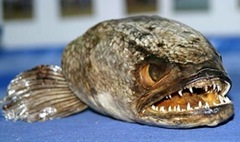Think again.
This isn’t one of those silly hijackers requiring you to dance around with a bottle of 409 hoping the neighbors don’t notice, this sure ain’t something you can point a finger at and bemoan it’s presence – no, this is something much better, with big sharp teeth that abducts terriers and small children.
“Frankenfish”, aka, the “Giant Snakehead” is forty seven times more deadly than a McDonald’s Big Mac, and can consume an adult human in a week or so … depending on its mood.

The species easily adapts to any freshwater habitat, including ponds, lakes, reservoirs, swamps, streams and drains. Eggs are laid in a sunken nest of vegetation near the shore, and the young are fiercely guarded by the parents. Full grown specimens can cause severe injury to humans who might inadvertently step near the nest. Juveniles are striped brown and black, and travel in large shoals.
The IGFA record is a 39″ specimen weighing nearly 21 pounds. If it liked your submerged buttock, you’d sure know about it quickly.
Some poor fellow landed one in the River Witham in Britain, and the natural concern is they may have achieved a foothold on a new continent. No additional sightings have been confirmed, but a lot of ecologists are gnawing on their fingernails as a result.
Be very afraid, the Snakehead can breathe air and walks on land..
[youtube]http://www.youtube.com/watch?v=nmU7etSYYqI&feature=related[/youtube]
![]()
On a morbid personal note, (and because TC expects it) it’s about time we had a good stand up fight instead of a “bug hunt” – us or them, Baby. It may prove our finest hour.
Technorati Tags: giant snakehead, invasive species, eats everything

Sure, they’re ugly and invasive, but we may have found the only fish capable of controlling pike populations…
I once saw a video of guy catching these things by the bucket loads out of a tributary of the Potomac during a migration.
My advice… Punch your favorite exotic fish enthusiast in the face next time you see them.
[Sorry for the repeat, the original seems to have come up empty. delete as needed]
“The critics were quite nasty about the newcomers, variously described as scaly, voracious, monstrous and homely. They stole food from natives. They had sharp teeth. They ate their young…”
A description of the introduction of brown trout to US waters in 1883.
Also, “It has displaced resident trout from the small rivers and lakes of Montana, Colorado, New Mexico and other mountain states. The brook trout’s main victim is the cutthroat, so called for the bright slash of crimson under its jaw. Squeezed on one side by invasive brook trout, native cutthroats are also under challenge from rainbow trout…”
http://www.smithsonianmag.com/science-nature/10025006.html
Carp introduced in the US 1877…
Striped Bass introduced in Sacramento Delta in 1879…
Peacock Bass Introduced in Florida in 1984…
Not saying that snakeheads are a good thing, but they’re far from the worst invasive species case (see Lake Davis). And they’re not as horrific as the sensationalist reporting in the media portends:
http://nationalzoo.si.edu/Publications/ZooGoer/2004/2/snakehead.cfm
Anecdotally, from first hand experience down in Florida, snakeheads don’t seem to be the voracious uber predators they are made out to be. They’re actually pretty wary. And in the waters I’ve fished, the largemouth bass still outnumber them by FAR, despite the snakeheads having a few years to establish a population and supposedly decimate everything.
You’re still supposed to kill them when you catch them…
Not sure why Pete’s comments are not viewable, they’re intact but not displaying.
Pingback: INVASIVE SPECIES: What of the Snakehead? « Fishing Jones
Pingback: INVASIVE SPECIES: What of the Snakehead? « Fishing Jones
Hi, I came from the part of the world (Indonesia) where the giant snakehead originates. It definitely have sharp teeth and has big appetite but I do not see them as aggressive (like chiclids). I pet some of them in my tank along with other predatory fish from around the world. They will become very aggressive when spawning but its natural as most animals do. There are stories of attacks to human getting near their nest but so far no fatalities. They do not consume human flesh and they do not take children as part of their diet. There is; however, another species which does: the Wallago Leerie or local name Tapah. This species can grow gigantic to 3 meter long.
I agree with what Pete said about introduced species, as long as in the introduced area there exist a matching predator nature will find its way to balance things. It is only if there is no co-predator around (that can prey on the introduced species) and human intervention (this is the worst factor), balance in nature will be destroyed.
Just my opinion ….
Btw, great site you have and contains many useful information.